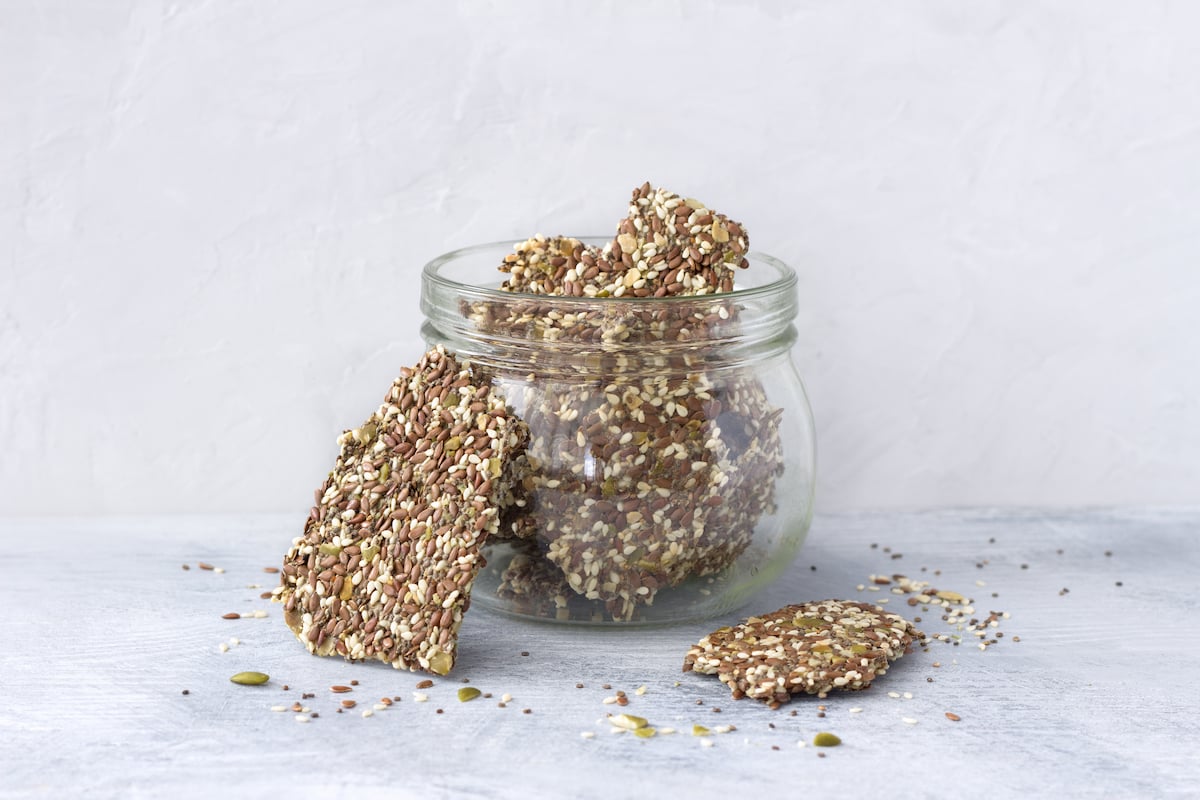There are many benefits to going low-carb or keto. These diet approaches, which optimize your ability to burn fat and ketones for fuel (as opposed to predominantly burning glucose), are associated with improved insulin sensitivity and glucose control, weight loss, and mental health benefits. Some endurance athletes, like long-distance runners, even do a portion of their training on low-carb, high-fat diets, so their bodies become efficient at using fat (including stored fat) as a fuel source—and less reliant on a constant inflow of carbs in the form of sugary gels and chews.
But maintaining these diet plans 100% of the time may not be ideal for everyone. For example, low-carb and keto diets can deplete muscle glycogen (the stored form of glucose), which, along with glucose from food, is your body’s preferred fuel source for high-intensity activities such as HIIT workouts or sprinting to the finish during a race. And for some people, particularly active people with low body fat, low-carb diets could potentially contribute to imbalances in certain metabolic hormones such as leptin and active thyroid hormone (T3). Plus, some people may find very low-carb and keto plans hard to sustain.
These are just a few reasons people have been turning to a carb-cycling plan—a loosely defined diet approach in which you spend most of your time in a low-carb state and periodically increase your carb intake to support various goals throughout a week, month, or year. However, this approach isn’t the same as a “cheat day,” in which you gorge on candy and donuts; there are ways to up your carb intake while maintaining stable blood sugar. Read on to learn more about carb cycling, who might benefit, the potential perks and pitfalls, and tips to do it in a metabolically healthy manner if you decide to try it.
What is carb cycling, and who might want to consider it?
There’s no exact or scientific definition of carb cycling, so many of its touted benefits are based on individual outcomes (versus scientific data), and the plans you see online can vary significantly, depending on who they’re targeting. Methods directed at bodybuilders may differ considerably from those for people who want to improve their health, for instance. But here’s the general premise: Eat low-carb or keto most of the time, then strategically eat more carbs on certain days (or at specific intervals) to support particular aims.
Low-carb eating creates a dynamic shift in metabolism: Instead of burning glucose from carbs, you burn predominantly fat and ketones. The body’s ability to switch between glucose and fat for energy is called metabolic flexibility. Consuming carbs in strategic intervals helps refill muscle glycogen (since carbs that aren’t immediately burned as fuel will be stored as glycogen—before being stored as fat—if glycogen levels are low) and may positively influence the secretion of hormones like leptin.
Ali Miller, RD, CDE, a functional medicine dietitian and certified diabetes educator, often uses carb cycling with her clients. What she’s seen: Among people who typically eat at a lower carbohydrate threshold, periodic carb cycles—or windows of consuming higher carbs—can support outcomes with exercise (enhanced endurance and performance), the microbiome (by providing more fiber than traditional low-carb diets), and metabolic hormones.
How might carb cycling work in real life? For athletes and fitness enthusiasts, working out in a low-carb or ketogenic state may offer a way to burn a higher percentage of fat (including stored fat) for a period of time. This can help improve body composition to hit a desired weight or body fat percentage. Then, consuming more carbs at strategic intervals (e.g., incorporating high-carb days surrounding specific athletic events) could help replenish muscle glycogen, so the body has an additional, more efficient fuel source for high-intensity activities (HIIT, hill sprints, strength training) or long-duration competitive events (a marathon, triathlon, bike race).
And for some women on low-carb diets—particularly lean, active women who struggle with issues like low energy levels, feelings of hunger, and menstrual irregularities—consuming additional carbs at strategic points in their menstrual cycle may provide relief by supporting levels of leptin, says Miller. [More on this below.]
“With carb-cycling, I’ve seen enhanced exercise endurance and performance, as well as improvements in hormones as demonstrated by healthy menstrual cycles and a return to ovulation after being anovulatory (not ovulating),” says Miller. “I’ve also seen leptin go from deficient to optimal.”
But carb cycling doesn’t have to be limited to these groups. Miller says it’s an option for almost anyone enticed by the benefits of a low-carb or keto lifestyle but wants a more flexible approach that limits potential downsides. [More on the potential benefits of carb-cycling below.]
What does a typical carb “cycle” look like?
There’s no one right way to carb cycle, according to Miller. The best approach for you will depend on your personal health goals and what feels good—and it will probably take some trial and error to nail down your ideal rhythm.
For example, you could carb cycle every week by eating low-carb for six days (5-10% of your daily calories from carbs, or 25-50 grams of carbs on a 2,000 calorie per day diet, is a popular range*), then eating relatively higher carb (1.5-2x your low-carb intake) for one day in conjunction with your most demanding workout or a social event. So if you typically eat 40 g of carbs, your high carbohydrate days would be 60-80 g. This doesn’t mean “high” carb—a massive blood sugar spike isn’t the goal—but it will be higher than your typical set point.
Related article:
When cycling carbs, it’s best to keep in mind the following advice for optimal metabolic health:
- Choose nutrient-dense whole food sources
- Avoid refined carbs and sugars
- Prioritize non-starchy vegetables whenever possible (greens, cabbage, bell peppers) with sparing amounts of nutritious starchy vegetables and legumes (sweet potatoes, carrots, squash, peas, beans, lentils)
- Emphasize high-fiber fruits that are rich in antioxidants, such as berries, citrus, and apples
- When eating higher-carb foods, pair them with healthy fat (such as olive oil) and protein to help minimize glucose spikes
- If you eat a meal higher in carbs, take a walk after eating (ideally within 30 minutes, though other time frames can help, too) to curb elevations in blood sugar and insulin
Another option is to eat low-carb for six to eight weeks, then higher-carb for a week—perhaps in conjunction with a vacation, a more intense training block or a higher activity level.
However, Miller warns against carb cycling too frequently. For the average person, that’s more than once a week, particularly if you’re trying to get into ketosis. It can take many people two to three days to get into ketosis, so if you carb up too often, you may never get there on your low-carb days.
One thing to note: increasing carbohydrate intake after being predominantly low-carb could potentially aggravate your gut, says Miller. So instead of doubling your carbs in one day, work up incrementally and see how you feel.
*Active people and athletes may need more. If you’re unsure, consider working with a registered dietitian.
What are the potential benefits of carb cycling?
The body of evidence on carb cycling is still small. However, there are some promising data on the individual elements of the approach. Here, we cover a few potential benefits based on Miller’s experience and research on low-carb diets, high-carb diets, and the impact of macronutrients on the body. Remember that benefits depend on your starting point, goals, individual physiology, and how you implement your carb cycles.
Adhering to a low-carb diet approach
The keto diet has real health benefits, but like any strict diet, it can be hard to sustain for those craving flexibility—and the occasional sweet potato. For some (but not all) people, diets like this can also lead to an all-or-nothing mentality, so that when they have a minor slip-up, they throw in the towel altogether and start loading up on all the foods they were trying to avoid. On the other hand, “carb cycling serves as a way of having liberation in a strict, standardized diet,” says Miller. You’re still maintaining a low-carb or keto diet for decent stretches of time, meaning you’ll experience some increased fat burn and potentially some fat loss, as well as elevation in ketones (which animal studies suggest may be anti-inflammatory and may combat oxidative stress). But you’ll also have periodic reprieves from the rigidness in the form of whole-food carbs like veggies, fruits, legumes, and the occasional healthier dessert, which can prevent palate fatigue.
Building metabolic flexibility
Metabolic flexibility—your body’s ability to efficiently shift between burning glucose and burning fat, based on what fuel is available—is a crucial marker of metabolic health. But when you regularly consume a high amount of carbs, your blood sugar is chronically elevated, which drives the continual release of insulin. One of insulin’s functions is to inhibit fat burning. Chronic high insulin can promote metabolic inflexibility, essentially making you dependent on glucose, which is associated with insulin resistance, Type 2 diabetes, cancer, and other metabolic diseases. So eating a generally low-carb diet has significant benefits. For beginners and people unwilling or able to go full keto, a carb-cycling diet offers a more approachable way to incorporate stretches of low-carb eating that activate fat-burning pathways—so you’re not stuck in sugar-burning mode.
Performance and recovery
Exercise intensity and duration dictate your body’s preferred fuel. Case in point: The human body burns more fat than glucose when operating below 60% of its maximal aerobic capacity, or VO2 max, which encompasses low-to-moderate intensity exercise that lasts less than 90 minutes. Beyond this “crossover point,” however, the body preferentially burns glucose (from dietary carbs or glycogen stores) to power high-intensity activities since glucose supplies the body with ATP more efficiently than fat.
What does this mean? Carbs are important for some, but not all, workouts. In fact, authors of a 2019 research review speculate that carb cycling or carb periodization—in which you’re low-carb on low-to-moderate intensity training days (and rest days) and higher carb for high-intensity training days—could offer the best of both worlds. That is, you could gain enhanced fat-burning and other beneficial metabolic adaptations during less strenuous workouts without compromising athletic performance and recovery on high-intensity days when your body needs more carbs. Similarly, a 2022 review of research around carbs as exercise fuel endorses increased carb intake before training or competition but matched with the intensity of the event. However, it also says that carb intake should be personalized and that a “periodized” approach (another term for carb cycling) may be best.
Several studies support this notion. Performing low-to-moderate intensity aerobic exercise in a low-carb state has been associated with benefits such as reduced formation of lactate (a biomarker for fatigue) and increased mitochondrial biogenesis, or the creation of new mitochondria, which is vital for energy production, combating oxidative stress, and delaying muscle fatigue. It also significantly increases fat burning. In a study on keto-adapted runners, peak fat oxidation was 2.3 times greater compared to high-carb runners.
On the other hand, training with higher carb availability increases exercise capacity and performance during high-intensity activities. In contrast, training with limited carb availability can limit the duration and intensity of an exercise session (which could compromise long-term performance goals). Some research also indicates that low-carb, ketogenic diets may blunt the increase in muscle mass that results from resistance training.
All of which is to say, cycling carbs in or out of your diet based on the demands and goals (such as building muscle) of your workout could offer greater benefits than sticking to one intake level.
Hormone balance
While there’s little research on carb cycling and hormones, there’s reason to believe that low-carb and keto diets have the potential to support healthy hormones in many people. Eating fewer carbs is associated with reduced hyperinsulinemia (high insulin levels) and improved insulin sensitivity. In a study on women with PCOS—a condition characterized by insulin resistance, elevated testosterone, and impaired fertility—following a keto-Mediterranean diet was linked to improvements in insulin resistance, reduced testosterone levels, and beneficial elevations in estrogen and progesterone.
That said, sustained low-carb and keto diets also have the potential to throw hormones out of whack for certain people. These diets have been associated with decreased leptin, irregular periods, and low T3 (active thyroid hormone, which impacts metabolism and body weight). In Miller’s experience, lean, highly active women with high levels of the stress hormone cortisol tend to be at the most significant risk for these imbalances. This may be primarily related to leptin, which then impacts other hormones.
Leptin’s job is to signal how much energy is available to the body. It is secreted by fat tissue and in response to elevations in blood glucose and insulin, which results in feelings of satiety. But if you’re on a low-carb diet and you don’t have much body fat, your leptin levels are more likely to be low, says Miller, based on what she sees in clients. That can drive hunger and irregular menstrual cycles and potentially alter thyroid hormones. One of the main reasons Miller uses carb-cycling plans with her keto clients is to restore healthy levels of leptin, and she’s seen that it can have a cascade of positive effects such as improved satiety (i.e., less hunger), more regular periods, and improved fertility.
Microbiome benefits
You can use a carb-cycling meal plan to support the gut microbiome—which, in turn, dramatically impacts metabolic health. While research is mixed on the way high-fat, low-carb diets influence the gut microbiome, some studies suggest that they feed the growth of problematic gut bacteria and stifle beneficial ones. This is likely due, in part, to lower fiber intake. The good news: Carb cycling offers more opportunities to pack in beneficial fiber in the form of veggies, fruits, legumes, and other whole-food carbs. This increased fiber, in turn, serves as a source of fuel for good bacteria residing in your gut, leading to the production of beneficial compounds called short-chain fatty acids (SCFAs) that support the production of glucose-regulating hormones.
Eating ample fiber is also vital for maintaining a healthy gut mucus barrier and keeping inflammation in check. In a fiber-deprived state, your gut bacteria will start to eat away at the beneficial mucus layer lining your intestines, which can promote the leakage of food particles and toxins into your bloodstream (i.e., leaky gut) that promote chronic inflammation, which underlies a range of metabolic disorders.
Related article:
How to start carb cycling
Remember, there’s no set definition for carb cycling, so there’s no specific correct approach for a carb-cycling plan. The key is tailoring it to your unique goals and needs, focusing on nutrient-dense foods, and listening to your body. Here are a few tips to help set yourself up for success:
- Figure out your goals and outline a schedule: Carb cycling for general health and metabolic flexibility? Carb cycling for hormones? Carb cycling to support a fitness target? Get clear on your goals and plan your schedule accordingly. Consulting with a registered dietitian may be helpful, especially if you have a health condition or upcoming athletic event that you’re unsure how to account for.
- Calculate macros for low-carb and higher-carb days: This part will be easier if you follow a low-carb or keto diet. Once you’ve established your baseline macros, you can use Miller’s tip of eating 1.5-2 times your baseline carbs on your higher-carb days. Adjust your fat and protein accordingly to stay within your desired calorie range. From there, you can use a tracking app or a food journal to ensure you’re hitting your desired numbers—at least until you get into the swing of things. And ensure you’re still getting appropriate levels of protein, fiber, and fat in each cycle.
- Consider using a CGM and testing ketones: A CGM can help you understand the impact of carb cycling on your blood sugar. On higher carb days, “we’d expect glucose to be higher than when you’re at a more restricted carb level, but we don’t want to see glucose above 120 mg/dL for more than an hour,” says Miller. (Note that Levels experts suggest keeping glucose below 110 mg/dL post-meal.) Testing ketones during low-carb stretches can also help reveal whether you’re metabolizing fat more efficiently.
- As much as possible, prioritize foods that support metabolic health. When you cycle carbs into your diet, maintain reasonable thresholds and avoid sending your body on a massive blood sugar roller coaster.
- Focus on how you feel, and adjust as needed. Give yourself time on a new carb-cycling schedule to see if it elicits the desired outcomes. If not, or if you’re experiencing some unpleasant side effects like low energy, it’s time to make some adjustments. Again, consulting a nutritionist may be helpful.










